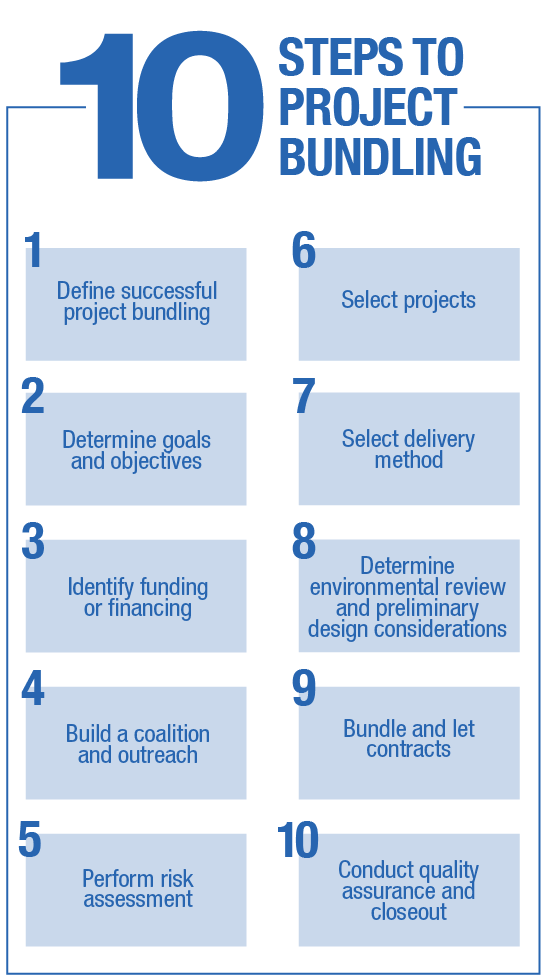When highway agencies apply the advanced project bundling techniques promoted in Every Day Counts round five (EDC-5), they optimize resources, save delivery time, and address system performance goals while keeping crucial transportation assets in good repair.
“The Federal Highway Administration identified best practices from around the country to develop a 10-step approach to bundling,” said David Unkefer, FHWA construction and project manager engineer. “States have also demonstrated a more programmatic and strategic approach to routinely maximize economies of scale.”
Project bundling is guided by selection criteria for capitalizing on benefits. “This strategic approach reduces costs and saves design and construction time,” said Romeo Garcia, FHWA bridge construction engineer. “Also, combining several projects into a single contract award stretches taxpayer dollars.” When bundling criteria are applied early in project programming, agencies can target high return on investment in asset management while realizing savings throughout project development and construction.
Bundled projects may be procured with a variety of contracting methods and agreement types, such as design-bid-build, indefinite delivery/indefinite quantity, construction manager/general contractor, and public-private partnerships (P3). Bundles may cover one county or the entire State and incorporate innovative construction techniques and financing tools. Contracts may combine work types, such as design, preservation, or replacement. A project bundling program paves the way to achieve agency goals.
“Project bundling is not just for large contracts. Bundles have ranged from two to 300 projects,” said Garcia. “Depending on an agency’s needs, smaller bundles can help keep the local contracting community engaged, while larger bundles offer opportunities for small and disadvantaged businesses.”

Twenty-three States are working to advance implementation of project bundling during EDC-5, including a number of agencies that use bundling to achieve savings and efficiency on bridge projects.
The Pennsylvania Department of Transportation (PennDOT) developed a local bridge bundling program that targets replacement of single-span bridges. To maximize efficiency, PennDOT groups bridges with similar details in a bundle. The goal is to use one design for all structures in a bundle, replacing multiple bridges of varying lengths with one standard-length bridge design. Bundles may be large, but contracts are developed in groups of 7 to 10 to optimize construction crews.
PennDOT has documented significant savings in design and construction from using this bundling method—up to 50 percent on design cost and up to 15 percent on construction cost compared to traditional single-bridge projects. Because of the savings, PennDOT waives the normal 5 percent local public agency contribution to a project, making the program popular among localities.
Freeway lighting is another project type that can benefit from bundling. In a metropolitan Detroit project, the Michigan Department of Transportation entered into a P3 agreement to improve lighting on five interstate corridors where just 70 percent of the lights functioned. The project bundled the replacement and maintenance of 15,000 lights for 15 years. The project improved freeway visibility and safety while achieving energy savings by replacing high-pressure sodium and metal halide lights with efficient light-emitting diode fixtures. Other transportation agencies—including those in Arizona, the District of Columbia, Florida, Illinois, Massachusetts, and Virginia—have bundled projects involving 15,000 to 70,000 streetlights.
The Indiana Department of Transportation (INDOT) reports freeing up to $50 million a year for other projects from savings on its bundling program. INDOT developed models for selecting the best projects to bundle that other agencies can adapt to their own needs. The agency conducted a study that examined the effects of contract size and other factors on the cost savings that can be achieved by bundling. Researchers used 9 years of data from 1,997 bridge projects delivered via 715 INDOT contracts.
The study confirmed the benefits of bundling and produced models INDOT can use to select the most appropriate projects to bundle in the future. Researchers documented how unit costs decline as project bundle size increases. They also found that the degree to which projects in a bundle are similar is important in reducing project cost. Using study results, INDOT developed business rules for bundling strategically during early project programming, institutionalizing a process to allow for greater economies of scale throughout project delivery.
